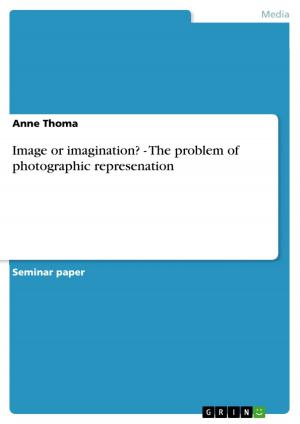Semiotics and Shock Advertisement
How and with which semiotic means do advertisers create a shocking effect?
Business & Finance, Marketing & Sales| Author: | Corinna Colette Vellnagel | ISBN: | 9783640836215 |
| Publisher: | GRIN Publishing | Publication: | February 18, 2011 |
| Imprint: | GRIN Publishing | Language: | English |
| Author: | Corinna Colette Vellnagel |
| ISBN: | 9783640836215 |
| Publisher: | GRIN Publishing |
| Publication: | February 18, 2011 |
| Imprint: | GRIN Publishing |
| Language: | English |
Essay from the year 2011 in the subject Communications - Public Relations, Advertising, Marketing, Social Media, grade: Excellent, The University of Surrey (Department of English), course: Language of Advertising, language: English, abstract: There is advertisement - and there is advertisement: Most ads have the intention to make people aware of a product, service or concept followed by the purchase and therefore 'support the free-market economy' (Reschke: 1998, p. 1); but there are ads whose main aim is to inform people, more precisely to call their attention to a certain topic. Consequently, advertisements cause different reactions: Some ads make people smile or even giggle; some just communicate plane information; whilst others make people think and reflect; and again others literally shock people. Advertising campaigns such as the WWF 9/11 one, the 'Get unhooked' ads or Antonio Federici's banned campaign (q.v. Appendix 1-3) are only three examples on the list of campaigns banned in the 21st century due to unethical content. Those offensive advertisements include 'messages that transgress laws and customs (e.g. anti-human rights), breach a moral or social code (e.g. profanity, vulgarity) or outrage the moral or physical senses (e.g. gratuitous use of violence, use of disgusting images)' (Chan et al.: 2007, p. 608). Researchers found out that adverts, which 'are incongruent with social norms attract attention and are more likely to be retained in memory' (Gulas and Weinberger: 2006, p. 173). Attracting interest can be done on different ways: by either using attention attracting pictures, sounds, signs or just simple words and phrases.
Essay from the year 2011 in the subject Communications - Public Relations, Advertising, Marketing, Social Media, grade: Excellent, The University of Surrey (Department of English), course: Language of Advertising, language: English, abstract: There is advertisement - and there is advertisement: Most ads have the intention to make people aware of a product, service or concept followed by the purchase and therefore 'support the free-market economy' (Reschke: 1998, p. 1); but there are ads whose main aim is to inform people, more precisely to call their attention to a certain topic. Consequently, advertisements cause different reactions: Some ads make people smile or even giggle; some just communicate plane information; whilst others make people think and reflect; and again others literally shock people. Advertising campaigns such as the WWF 9/11 one, the 'Get unhooked' ads or Antonio Federici's banned campaign (q.v. Appendix 1-3) are only three examples on the list of campaigns banned in the 21st century due to unethical content. Those offensive advertisements include 'messages that transgress laws and customs (e.g. anti-human rights), breach a moral or social code (e.g. profanity, vulgarity) or outrage the moral or physical senses (e.g. gratuitous use of violence, use of disgusting images)' (Chan et al.: 2007, p. 608). Researchers found out that adverts, which 'are incongruent with social norms attract attention and are more likely to be retained in memory' (Gulas and Weinberger: 2006, p. 173). Attracting interest can be done on different ways: by either using attention attracting pictures, sounds, signs or just simple words and phrases.















